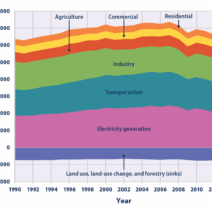In an era defined by climate change, the urgency to address global warming has never been more pronounced. While large-scale systemic changes are essential, individual actions at home can collectively lead to profound effects. By adopting certain habits, one can contribute significantly to curtailing greenhouse gas emissions, thus playfully redefining our relationship with the planet.
To begin, it’s crucial to recognize that energy consumption in households is a primary driver of carbon emissions. Appliances, lighting, and heating systems contribute substantially to our carbon footprint. Therefore, the first step towards an eco-friendly home involves an energy audit. Understanding where energy is being wasted empowers homeowners to make informed decisions. Consider transitioning to energy-efficient appliances. The Energy Star label is your friend; it signifies that the device meets stringent efficiency guidelines, which can drastically reduce energy consumption without sacrificing performance.
Next, let us delve into the world of lighting. Traditional incandescent bulbs have long been the norm, but compact fluorescent lamps (CFLs) and light-emitting diodes (LEDs) are revolutionizing home illumination. Not only do these alternatives use less energy, but they also boast heightened longevity, minimizing not only energy consumption but also waste. The curious homeowner can even experiment with smart lighting systems that provide the added benefit of automation and remote control, further optimizing energy use.
Heating and cooling systems are notorious for their energy demands. One effective habit to adopt is the strategic use of thermostats. Lowering the thermostat by just one degree in winter, or raising it in summer, can yield substantial savings on energy bills, aligning economic and ecological benefits seamlessly. Additionally, embracing natural ventilation can reduce reliance on mechanical air conditioning. Opening windows during cool evenings or leveraging cross-ventilation during the day can maintain a comfortable indoor climate naturally.
The significance of insulation cannot be overstated. Properly insulated homes reduce the need for excessive heating and cooling, facilitating a sustainable temperature balance year-round. Homeowners are encouraged to scrutinize their insulation, paying particular attention to attics, basements, and areas around windows and doors. Simple measures like weather stripping or caulking can drastically alter a home’s energy profile, leading to reductions in both energy costs and carbon emissions.
Another impactful stride towards a greener home is by reevaluating water usage. Water heaters, for instance, consume significant energy. By simply lowering the water heater temperature and insulating pipes, homeowners can enhance energy efficiency. Rainwater harvesting systems offer a more progressive approach, effectively utilizing natural precipitation for irrigation and other non-potable uses. Such systems not only conserve water but also alleviate the burden on municipal water treatment facilities.
Culinary habits contribute to household emissions more than one might expect. The environmental footprint of food choices can be diminished by adopting a plant-rich diet. The production of animal products is considerably resource-intensive and contributes to greenhouse gas emissions. Transitioning to plant-based alternatives, or at minimum, incorporating more vegetables into one’s diet, can yield a dual advantage: personal health and planetary well-being.
Furthermore, the emphasis on local and seasonal foods cannot be overlooked. By choosing to support local farmers and markets, consumers reduce the need for transportation, which is a major contributor to carbon emissions. A striking curiosity about this approach is the added bonus of freshness and flavor often associated with local produce. Exploring new recipes centered around seasonal ingredients can even be an adventurous culinary journey for the entire family.
Extending the principles of sustainability to waste management is another essential component of a greener home. Households produce a significant amount of waste, much of which is recyclable or compostable. Implementing a comprehensive recycling system at home can drastically minimize landfill contributions. Composting kitchen scraps transforms waste into nutrient-rich soil, thus closing the loop and enriching the household’s gardening efforts.
Moreover, being mindful of consumptive habits contributes significantly to the reduction of waste. Adopting the “reduce, reuse, recycle” mantra can shape purchase decisions. Before buying, consider whether the item is necessary or if a second-hand version would suffice. Embracing a minimalist approach can lead to a decluttered space and a clearer conscience in terms of consumption.
Lastly, fostering an eco-conscious mindset within the household is paramount. Engaging family members in discussions about climate change, its impacts, and actionable strategies can create a united front. Children, when educated about their carbon footprints and the significance of environmental stewardship, can become stewards of change for generations to come. Sharing insights through creative means—be it gardening, DIY projects, or even family outings and nature walks—can pique curiosity and ignite a passion for sustainability.
In summary, preventing global warming from your home is a series of manageable, though impactful, habits that anyone can adopt. Energy efficiency, water conservation, dietary choices, and mindful consumption all pave the path to a greener existence. Each individual action, when aggregated, can culminate in substantive change, shifting perspectives and rekindling the intrinsic bond between humanity and nature. By embracing these habits, you not only contribute to the fight against climate change but also set the foundation for a sustainable future.






